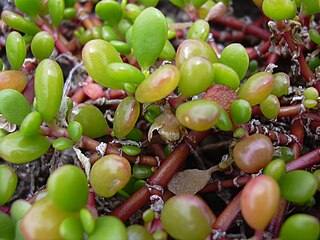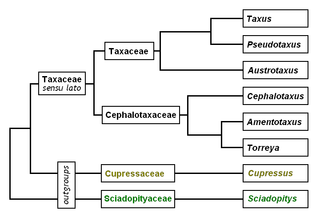
The Aizoaceae, or fig-marigold family, is a large family of dicotyledonous flowering plants containing 135 genera and about 1800 species. They are commonly known as ice plants or carpet weeds. They are often called vygies in South Africa and New Zealand. Highly succulent species that resemble stones are sometimes called mesembs.
Purslane is a common name for several mostly unrelated plants with edible leaves and may refer to:
Cat's claw or cat's claws is a common name for several plants:

Sesuvium edmonstonei, commonly known as Galapagos carpet weed, is a species of plant in the family Aizoaceae. It is endemic to the Galápagos Islands (Ecuador).

Sesuvium is a genus of flowering plants in the ice plant family, Aizoaceae. The roughly eight species it contains are commonly known as sea-purslanes.
Ice plant or iceplant may refer to:

Sesuvium portulacastrum is a sprawling perennial herb that grows in coastal areas throughout much of the world. It is commonly known as shoreline purslane or (ambiguously) "sea purslane," in English, dampalit in Tagalog and 海马齿sl in chinese.

Caryophyllales is a diverse and heterogeneous order of flowering plants that includes the cacti, carnations, amaranths, ice plants, beets, and many carnivorous plants. Many members are succulent, having fleshy stems or leaves. The betalain pigments are unique in plants of this order and occur in all its families with the exception of Caryophyllaceae and Molluginaceae.

In botany, succulent plants, also known as succulents, are plants with parts that are thickened, fleshy, and engorged, usually to retain water in arid climates or soil conditions. It is a characteristic that is not used scientifically for the definition of most families and genera of plants because it often can be used as an accurate characteristic only at the single species level. The word succulent comes from the Latin word sucus, meaning 'juice', or 'sap'. Succulent plants may store water in various structures, such as leaves and stems. The water content of some succulent organs can get up to 90–95%. Some definitions also include roots, thus geophytes that survive unfavorable periods by dying back to underground storage organs may be regarded as succulents. In horticultural use, the term succulent is sometimes used in a way that excludes plants that botanists would regard as succulents, such as cacti. Succulents are often grown as ornamental plants because of their striking and unusual appearance, as well as their ability to thrive with relatively minimal care.
Sea pickle is a common name for several plants and animals and may refer to:

Sesuvium verrucosum is a species of flowering plant in the family Aizoaceae known by the common names western sea-purslane and verrucose sea-purslane. It is native to the Americas, where it can be found in the southwestern quadrant of the United States, Mexico, and parts of South America. It grows in many types of saline and alkaline habitat types on the coast and inland, including salt marshes and other saline wetlands, alkali flats, and drying desert washes. It is a perennial herb producing many branching prostrate stems up to a metre long, forming a mat up to two metres wide. The herbage is verrucose, covered densely in crystalline bumps. The stems are lined with leaves of varying shapes which measure up to 4 cm long. Flowers occur in the leaf axils. They have no petals, but the five, pointed sepals are generally bright pink to reddish or orange in color with a thick, verrucose outer surface. At the centre of the flower is a ring of stamens around the central ovary. The fruit is a capsule about 500 mm long containing many seeds.

Yew is a common name given to various species of trees.
Gunniopsis quadrifida, the Sturts pigface, is a plant endemic to Australia that is within the family Aizoaceae. This family consists of a diverse array of species that inhabit arid and/or saline coastal and inland areas, with the plants displaying leaf morphology that is conducive to such harsh environments. Typical features of members of this genus that lie within this family of succulents includes the presence of fleshy-leaves that acts as a water reservoir for the plant with the habit of a smalls shrub.

Sesuvium maritimum is an annual herbaceous plant native to southeastern North America in the family Aizoaceae. This species is commonly known as the annual or slender sea purslane. It can be found on sandy beaches, salt marshes, or other coastal regions.
This page is based on this
Wikipedia article Text is available under the
CC BY-SA 4.0 license; additional terms may apply.
Images, videos and audio are available under their respective licenses.








